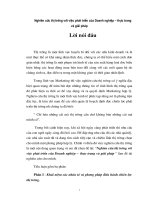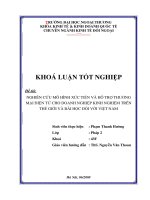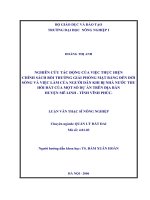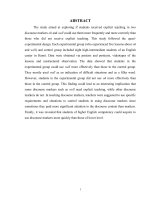Một nghiên cứu thí điểm về việc thực hiện một khóa học điện tử cho giáo dục lâm sàng trong y học miệng
Bạn đang xem bản rút gọn của tài liệu. Xem và tải ngay bản đầy đủ của tài liệu tại đây (382.25 KB, 12 trang )
Knowledge Management & E-Learning, Vol.7, No.3. Sep 2015
Knowledge Management & E-Learning
ISSN 2073-7904
A pilot study on implementation of an e-learning course
for clinical education in oral medicine
Vlaho Brailo
University of Zagreb, Croatia
Ivica Richter
Fužine, Croatia
Ana Andabak Rogulj
Vanja Vučićević Boras
University of Zagreb, Croatia
Ivana Škrinjar
Clinical Hospital Center Zagreb, Croatia
Recommended citation:
Brailo, V., Richter, I., Andabak Rogulj, A., Vučićević Boras, V., &
Škrinjar, I. (2015). A pilot study on implementation of an e-learning
course for clinical education in oral medicine. Knowledge Management &
E-Learning, 7(3), 507–517.
Knowledge Management & E-Learning, 7(3), 507–517
A pilot study on implementation of an e-learning course for
clinical education in oral medicine
Vlaho Brailo*
School of Dental Medicine
University of Zagreb, Croatia
E-mail:
Ivica Richter
Private Dental Practice
Fužine, Croatia
E-mail:
Ana Andabak Rogulj
School of Dental Medicine
University of Zagreb, Croatia
E-mail:
Vanja Vučićević Boras
School of Dental Medicine
University of Zagreb, Croatia
E-mail:
Ivana Škrinjar
Department of Oral Medicine
Clinical Hospital Center Zagreb, Croatia
E-mail:
*Corresponding author
Abstract: This study presents the process of implementing an e-learning course
for clinical education in oral medicine and examines its impact on students’
knowledge and satisfaction. Thirty six (39.6%) fifth-year undergraduate
students participated in the study. Every week before their clinical practice,
students studied relevant e-learning materials and completed an assessment test.
At the end of the semester, students’ knowledge and attitudes towards elearning were assessed by the knowledge test and anonymous questionnaire.
Students who had access to the e-learning course had significantly better
knowledge than students who did not have access to the e-learning course.
Exposure to the e-learning course contributed to a better understanding of oral
medicine curriculum, increased confidence with oral medicine patients and
easier participation in oral medicine clinical practice. This study provided
evidence that the e-learning can be implemented as a valuable adjunct to
508
V. Brailo et al. (2015)
clinical education in oral medicine.
Keywords: Clinical education; e-Learning; Knowledge assessment; User
satisfaction
Biographical notes: Vlaho Brailo, DMD, PhD is Assistant Professor at the
Department of Oral Medicine, School of Dental Medicine, University of
Zagreb, Croatia. He is the chairman of the e-learning committee at his
institution. He participates in professional activities related to advancing oral
medicine clinical care, research and education through IT.
Ivica Richter is a Ph.D. student at the Department of Oral Medicine, School of
Dental Medicine, University of Zagreb, Croatia.
Ana Andabak Rogulj, DMD, PhD is post doctorate fellow at the Department of
Oral Medicine, School of Dental Medicine, University of Zagreb, Croatia
involved in the development of e-learning curriculum in oral medicine.
Vanja Vučićević Boras, DMD, PhD is the Head of the Department of Oral
Medicine, School of Dental Medicine, University of Zagreb, Croatia involved
in the development of e-learning curriculum in oral medicine.
Ivana Škrinjar, DMD is oral medicine specialist at the Oral Medicine Unit,
Clinic for Dentistry, University Hospital Centre, Zagreb Croatia involved in the
development of e-learning curriculum in oral medicine.
1. Introduction
At the School of Dental Medicine, University of Zagreb, oral medicine is taught for four
semesters (7th, 8th, 9th and 10th semesters). The first two semesters (7 and 8) consist of
lectures, seminars and preclinical exercises. Semesters 9 and 10 consist of clinical
practice under the supervision of a tutor. After completing the 10 th semester students take
the final exam which consists of 45 multiple choice questions. Transition to the clinical
portion of the education rarely goes smoothly. Students tend to forget materials taught
through lectures and seminars. They usually begin studying only a few weeks before their
exams and they often lack theoretical knowledge necessary for active participation in the
clinical working with oral medicine patients.
Our primary task was to find a way to motivate students to become more prepared
for their clinical work because we do not want to spend precious clinical time on
repeating materials that students should already have learned from lectures and seminars.
Clinical sessions last 90 minutes and review sessions would take a minimum of 20-30
minutes from this time.
e-Learning came up as a logical solution as it offers flexibility for learning
independent of place and time constraints. Students may access teaching materials from
anywhere, individualize their learning process and learn at their own pace (Puljak &
Sapunar, 2011). Unlike “classical” teaching methods such as lectures and seminars,
where the teacher transfers knowledge and students are passive recipients, e-learning
promotes active learning where students become creators of their own base knowledge
(DeBate et al., 2011; Gadbury-Amyot & Brockman, 2011). Another advantage of elearning is that students can access learning materials several times as opposed to only
having one exposure shared through a lecture or a seminar. Furthermore, e-learning offers
Knowledge Management & E-Learning, 7(3), 507–517
509
environments free from distractions which often cannot be avoided in lecture halls
(Rosenberg, Grad, & Matear, 2003). Studies have shown that e-learning is at least as
effective as other learning methods in dental education and that students generally have
positive attitudes towards it (Mattheos et al., 2008; Rosenberg, Grad, & Matear, 2003).
The research questions of the study include the following:
Can e-learning course be implemented in the clinical education in oral
medicine?
What is the impact of the e-learning course on students’ knowledge?
How are students satisfied with the new teaching method in their oral
medicine education?
2. Materials and methods
2.1. Description and administration of the e-learning course
A free version of the eFront e-learning platform (Epignosis LLC, USA) was used to
create the course. The course was introduced in the 9th semester as a supplement to the
clinic and consisted of 15 modules in the 9th and 15 modules in the 10th semester. In the
9th semester, each module consisted of theoretical materials covering examination of the
oral medicine patient, laboratory testing in oral medicine, medication prescription,
writing referral letters, most common oral lesions etc. Each module also had a quiz to
assess students’ knowledge. Multiple choice questions, open-ended questions, true/false
questions, and matched pairs were used in the quizzes.
Every week before the clinic students were obliged to study the module materials
and complete the quiz (10-20 questions). The system automatically calculated the
percentage of correct answers giving students immediate feedback on their performance.
The threshold was set to 80% correct answers. Students had the opportunity to access
materials and take the test as many times as they preferred. Without completing the quiz,
a student’s attendance in the clinical portion of the class was not registered. In this way, a
high level of knowledge about each module and students’ preparedness for clinical work
was achieved.
In the 10th semester, the e-learning focus was on the application of acquired
knowledge in realistic clinical situations. Students were assigned a virtual patient case
scenario (Department’s clinical photo archive was used) every week, where they had to
establish a correct diagnosis, perform corresponding laboratory tests, and prescribe a
treatment. Procedural sequencing was similar to the procedures done in real-life. A forum
for comments and exchange of ideas related to each case was also made available to
students.
Along with the clinical case, every week students had to solve a quiz that included
material taught in the 9th semester. These quizzes were more complex and required higher
levels of knowledge according to Bloom’s taxonomy (such as analysis and synthesis)
than the quizzes from the 9th semester (which were based on remembering and
understanding) (Bloom, Engelhart, Furst, Hill, & Krathwohl, 1956).
As this was a pilot project, the e-learning course was available to 36 out of
91(39.6%) of the fifth year undergraduate students. e-Learning course participation was
decided by the clinical tutor.
510
V. Brailo et al. (2015)
2.2. Outcome measures
The aim of this study was to assess students’ knowledge and attitudes towards e-learning.
Informal survey was used for that purpose. Knowledge was assessed by 14 open-ended
questions at the beginning of the 10th semester. The questions were also distributed to the
control group of students who did not have access to the e-learning course. Answers were
checked by a single investigator (AAR). Possible score was 0, 0.5 and 1 point for each
question.
Attitudes towards the e-learning course were measured at the end of the 10th
semester, after the final exam. Five-point Likert scale that determined level of agreement
(1- strongly disagree to 5 – strongly agree) with each of the 11 statements was used.
Furthermore, we compared the final exam grades between the students who had
access to the e-learning course and the students who did not have access to the e-learning
course. The exam grades were numerical (1 to 5).
2.3. Data analysis
Numerical data (i.e. 0, 0.5 or 1 for knowledge assessment and 1-5 for attitudes and exam
grades) were organized in MS Excel (Microsoft Excel, Microsoft Inc. USA) spreadsheets
and processed using SPSS 20.0 software (IBM Inc., USA). Differences between the two
groups were assessed by the chi-square test and student’s t-test when applicable. p values
lower than 0.05 (p<0.05) were considered statistically significant.
3. Results
3.1. General data
Thirty six fifth year undergraduate students participated in the e learning course. Control
group consisted of 55 fifth year undergraduate students who did not have the access to
the e learning course. Student characteristics and their use of e-learning software are
shown in Table 1.
Table 1
Student characteristics and their use of e-learning software
Sex
N
Females
30
Males
6
Average time
spent weekly in
the course
<30
30-60
60-90
90-120
>120
min
min
min
min
min
3
19
6
6
2
(8.3%)
(52.8%)
(16.7%)
(16.7%)
(5.6%)
It took too
much of my
time
It took much
of my time
It took neither
little, nor much
of my time
It took little
of my time
It took very
little of my
time
N (%)
With regard to
other curricular
activities how
Knowledge Management & E-Learning, 7(3), 507–517
511
much of your
time did this
activity take?
N (%)
On average, how
difficult for you,
was it to solve the
assessment test?
0
1
6
17
12
(0%)
(2.8%)
(16.7%)
(47.2%)
(33.3%)
Very difficult
Difficult
Neither
difficult, nor
easy
Easy
Very easy
0
1
9
24
2
(0%)
(2.8%)
(25%)
(66.7%)
(5.6%)
1
1-2
2-3
3-4
4 and more
11
21
4
0
0
(30.6%)
(58.3%)
(11.1%)
(0%)
(0%)
Very
complicated to
use
Complicated
to use
Neither
complicated,
nor easy to use
Easy to use
Very easy
to use
0
0
3
12
21
(0%)
(0%)
(8.3%)
(33.3%)
(58.3%)
Very negative
Negative
Neither
negative nor
positive
Positive
Very
positive
0
0
1
11
24
(0%)
(0%)
(2.8%)
(30.6%)
(66.6%)
N (%)
On average how
many attempts
did it take you to
solve the
assessment test?
N (%)
Opinion on the
use of the elearning software
N (%)
General opinion
of the e-learning
course
N (%)
3.2. Students’ knowledge
As shown in Fig. 1, students who had access to the e-learning course had significantly
higher number of correct answers than the students who did not have access to the elearning course (6.6 ± 2 vs. 1.9 ± 1.5; p=0.0003) as assessed by the 14 open ended
questions at the beginning of the 10th semester. The bars in Fig. 1 represent average
number of correct answers ± one standard deviation. Significant difference between
students who had access to the e-learning and students who did not have access to the elearning course was observed.
512
V. Brailo et al. (2015)
Fig. 1. Results of knowledge testing at the end of the 9th semester
As shown in Fig. 2, no difference in the final exam grades at the end the 10th
semester, was observed between the students who had access to the e-learning course and
the students who did not have access to the e-learning course (p=0.414). The bars in Fig.
2 represent percentage of students with corresponding final grades. No difference
between students who had access to the e-learning and students who did not have access
to the e-learning course was observed.
Fig. 2. Distribution of final exam grades among students
Knowledge Management & E-Learning, 7(3), 507–517
513
3.3. Student satisfaction
Students’ attitudes and satisfaction with the e-learning course are displayed in Table 2. A
great majority of the students expressed positive attitudes towards the e-learning course.
Table 2
Students’ attitudes and satisfaction with e-learning
e-Learning course
contributed to a better
understanding of oral
medicine curriculum
Strongly
disagree
Disagree
Neither
disagree
nor agree
Agree
Strongly
agree
0
(0%)
0
(0%)
0
(0%)
9
(25%)
27
(75%)
0
(0%)
0
(0%)
1
(2.8%)
21
(58.3%)
14
(38.9%)
0
(0%)
0
(0%)
0
(0%)
23
(63.9%)
13
(36.1%)
0
(0%)
0
(0%)
4
(11.1%)
24
(66.7%)
8
(22.2%)
0
(0%)
3
(8.3%)
3
(8.3%)
21
(58.3%)
9
(25%)
1
(2.8%)
9
(25%)
11
(30.6%)
12
(33.3%)
3
(8.3%)
0
(0%)
1
(2.8%)
2
(5.6%)
12
(33.3%)
21
(58.3%)
0
(0%)
1
(2.8%)
4
(11.1%)
13
(36.1%)
18
(50%)
N(%)
e-Learning course made
participation in the oral
medicine clinic easier
N(%)
e-Learning course
contributed to a better
recognition of oral mucosal
lesions
N(%)
e-Learning course increased
my confidence with an oral
medicine patients
N(%)
e-Learning course increased
my interest in oral medicine
N(%)
I would have regularly
accessed e-learning
materials even if hadn’t had
the obligation to pass the
assessment test before every
clinic
N(%)
In my opinion, e-learning
should be regular part of
oral medicine curriculum
N(%)
In my opinion, e-learning
should be important part of
the undergraduate dental
education
N(%)
514
V. Brailo et al. (2015)
e-Learning course made
preparation for exam much
easier
0
(0%)
0
(0%)
1
(2.8%)
11
(30.6%)
24
(66.7%)
1
2
3
4
5
0
(0%)
0
(0%)
0
(0%)
6
(16.7%)
30
(83.3%)
1
(2.8%)
2
(5.6%)
7
(19.4%)
12
(33.3%)
14
(38.9%)
0
(0%)
1
(2.8%)
3
(8.3%)
10
(27.8%)
22
(61.1%)
N(%)
On a scale from 1-5 rate the
quality of e-learning
materials
(1- bad - 5- excellent)
N(%)
On a scale from 1-5 rate
how much did the elearning course help you to
pass the final exam
(1- didn’t help at all
5- significantly helped)
N(%)
On a scale from 1-5 rate
how much did the elearning course influence
your overall satisfaction
with the oral medicine
curriculum
(1- didn’t influence at all
5- significantly influenced)
N(%)
4. Discussion
e-Learning has proven its efficacy as a teaching method in various dental disciplines (AlJewair, Azarpazhooh, Suri, & Shah, 2009; Al-Jewair, Qutub, Malkhassian, & Dempster,
2010; Meckfessel et al., 2011; Mitov, Dillschneider, Abed, Hohenberg, & Pospiech, 2010;
Rosenberg, Grad, & Matear, 2003; Tan, Hay, & Whaites, 2009). Its use has been
described in the field of oral medicine as well (Jontell, Mattsson, & Torgersson, 2005;
Porter et al., 1996). Our results are in concordance with the aforementioned studies and
indicate that e-learning can be successfully integrated in oral medicine clinical education.
Exposure to the e-learning course contributed to a better understanding of the oral
medicine curriculum, increased students’ confidence with oral medicine patients and
made the participation in oral medicine clinic easier.
Exposure to real-life patients and hands-on clinical cases cannot often be achieved
in the oral medicine clinic due to time and place constraints as well as the prevalence of
certain oral disease in the general population. In a discipline where mucosal lesions can
Knowledge Management & E-Learning, 7(3), 507–517
515
have a great degree of variability, visual information from the textbooks and lectures is
often insufficient and may not reflect real life situations (Jontell, Mattsson, & Torgersson,
2005). As a result of the aforementioned circumstances, students are exposed to a limited
number of hands-on cases/oral lesions which will negatively affect their clinical
experience. With the use of the e-learning software and the Department’s photo/video
archive realistic clinical case scenarios can be created (as was done in this study). In this
way students can be exposed to a great number of virtual clinical cases and the
aforementioned problem can at least partially be alleviated. Furthermore, students can
practice clinical skills important for the management of oral medicine patients such as
describing oral lesions, ordering lab tests, writing referral letters and prescribing
medication. E-learning enables students to undertake these activities numerous times at
their own pace opposed to only 90 minutes per week in a real life clinical sessions. We
would however, like to emphasize that e-learning can by no means substitute student’s
encounter with the real patient, but can rather be used as a valuable adjunct to the clinical
education.
As the results of this study show, exposure to the e-learning course can positively
affect student’s knowledge. Students who were exposed to the e-learning course had
better knowledge than their colleagues who did not have access to the course. The
difference in knowledge was evident during the semester (as assessed by the knowledge
test) but not in the final exam grades. Students usually start studying few weeks before
the final exam and catch up with the curriculum which can explain the lack of difference
in the final exam grades.
Nevertheless, we believe that the e-learning course has fulfilled its purpose, as our
primary intention was to motivate the students to learn during the entire academic year
and have theoretical knowledge necessary for active participation in the clinic. The
element of obligation had to be present in order to assure regular attendance in the course,
as nearly one third of the students (27.8%) disagreed or strongly disagreed with the
statement “I would have regularly accessed e-learning materials even if hadn’t had the
obligation to pass the assessment test before every clinic”. In spite of the fact that
students had to be actively involved in the course for the entire academic year, they felt
that the e-learning course did not significantly interfere with their other curricular
activities and did not take much of their time.
Students expressed positive attitudes toward the e-learning course and found the
e-learning software easy or very easy to use. This is not surprising as the majority of the
students are born between 1988 and 1992 and belong to a so called Net generation. This
generation grew up surrounded with information technology and is very open to the use
of new technologies. Internet is very important part of their daily lives and a computer is
a medium that is more familiar for them than a textbook (Oblinger & Oblinger, 2008). In
spite of the students’ openness to the new technologies, quality of the e-learning materials
is more important for students’ satisfaction than the variety of media used for the creation
of the course (Tan, Hay, & Whaites, 2009). As stated by McNeely, technology should be
used “as a learning tool, not just the cool new thing” (McNeely, 2008). We believe that
we managed to meet students’ expectations as the great majority of the students (83.3%)
gave highest grade to the quality of the e-learning materials.
This study has several limitations. First of all, this was not a randomized control
trial. Students were not randomly assigned to the e-learning/non-e learning group. The
involvement in the e-learning course was based on the decision of the clinical tutor. The
study did not prove superiority of e-learning over classic teaching methods, but it
confirmed its value as an additional educational tool in oral medicine. Secondly, one
516
V. Brailo et al. (2015)
might argue that the sample was relatively small (36 students). However, we feel that the
responses from 39.6% of the fifth year students can predict trends in students’ learning
preferences and adoption of new technologies with a high degree of certainty.
5. Conclusion
e-Learning can provide innovative and interactive ways of presenting learning materials
and offers numerous possibilities that can facilitate learning process (Mattheos et al.,
2008; Rosenberg, Grad, & Matear, 2003). In a discipline like oral medicine where visual
information is essential for knowledge adoption, students can be exposed to a greater
number of oral lesions than is possible through classical learning tools such as textbooks
and lectures. Integration of various visual information such as clinical photographs and
videos enables teacher to create realistic case scenarios that can alleviate the problem of
physical constraints and low prevalence of some oral lesions in oral medicine practice.
This can increase student’s confidence in dealing with real-life clinical situations. In spite
of its limitations, this study provided evidence that e-learning can be implemented as a
valuable adjunct to clinical education in oral medicine.
References
Al-Jewair, T. S., Azarpazhooh, A., Suri, S., & Shah, P. S. (2009). Computer-assisted
learning in orthodontic education: A systematic review and meta-analysis. Journal of
Dental Education, 73(6), 730–739.
Al-Jewair, T. S., Qutub, A. F., Malkhassian, G., & Dempster, L. J. (2010). A systematic
review of computer-assisted learning in endodontics education. Journal of Dental
Education, 74(6), 601–611.
Bloom, B. S., Engelhart, M. D., Furst, E. J., Hill, W. H., & Krathwohl, D. R. (1956).
Taxonomy of educational objectives: Book 1: Cognitive domain. New York: David
McKay Company, Inc.
DeBate, R. D., Cragun, D., Severson, H. H., Shaw, T., Christiansen, S., Koerber, A.,
Tomar, S., Brown, K. M., Tedesco, L. A., & Hendricson, W. (2011). Factors for
increasing adoption of e-courses among dental and dental hygiene faculty members.
Journal of Dental Education, 75(5), 589–597.
Gadbury-Amyot, C. C., & Brockman, W. G. (2011). Transition of a traditional
pharmacology course for dental students to an online delivery format: A pilot project.
Journal of Dental Education, 75, 633–645.
Jontell, M., Mattsson, U., & Torgersson, O. (2005). MedView: An instrument for clinical
research and education in oral medicine. Oral Surgery, Oral Medicine, Oral
Pathology and Oral Radiology, 99(1), 55–63.
Mattheos, N., Stefanovic, N., Apse, P., Attstrom, R., Buchanan, J., Brown, P., Camilleri,
A., Care, R., Fabrikant, E., Gundersen, S., Honkala, S., Johnson, L., Jonas, I.,
Kavadella, A., Moreira, J., Peroz, I., Perryer, D. G., Seemann, R., Tansy, M., Thomas,
H. F., Tsuruta, J., Uribe, S., Urtane, I., Walsh, T. F., Zimmerman, J., & Walmsley, A.
D. (2008). Potential of information technology in dental education. European Journa
of Dental Education, 12(Suppl. 1), 85–92.
McNeely, B. (2005). Using technology as a learning tool, not just a cool new thing. In D.
Oblinger & J. Oblinger (Eds), Educating the net generation (pp. 4.1–4.10). Boulder,
CO: EDUCAUSE.
Meckfessel, S., Stühmer, C., Bormann, K.-H., Kupka, T., Behrends, M., Matthies, H.,
Vaske, B., Stiesch, M., Gellrich, N.-C., & Rücker, M. (2011). Introduction of e-
Knowledge Management & E-Learning, 7(3), 507–517
517
learning in dental radiology reveals significantly improved results in final
examination. Journal of Craniomaxillofacial Surgery, 39(1), 40–48.
Mitov, G., Dillschneider, T., Abed, M. R., Hohenberg, G., & Pospiech, P. (2010).
Introducing and evaluating MorphoDent, a web-based learning program in dental
morphology. Journal of Dental Education, 74(10), 1133–1139.
Oblinger, D., & Oblinger, J. (2008). Educating the net generation. Boulder, CO:
EDUCAUSE.
Porter, S. R., Telford, A., Chandler, K., Furber, S., Williams, J., Price, S., Scully, C.,
Triantos, D., & Bain, L. (1996). Computer assisted learning (CAL) of oral
manifestations of HIV disease. British Dental Journal, 181(5), 173–177.
Puljak, L., & Sapunar, D. (2011). Web-based elective courses for medical students: An
example in pain. Pain Medicine, 12(6), 854–863.
Rosenberg, H., Grad, H. A., & Matear, D. W. (2003). The effectiveness of computeraided, self-instructional programs in dental education: A systematic review of the
literature. Journal of Dental Education, 67(5), 524–532.
Tan, P.-L., Hay, D. B., & Whaites, E. (2009). Implementing e-learning in a radiological
science course in dental education: a short-term longitudinal study. Journal of Dental
Education, 73(10), 1202–1212.









